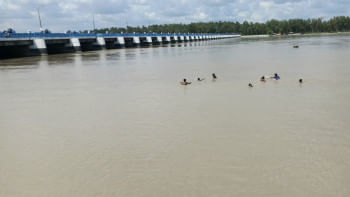Chattogram: A city of fading greenery

Once upon a time, the country's port city was celebrated for its lush vegetation and green hills. However, in the last three decades, the city has already lost half its greenery to unchecked, unplanned urbanisation.
A study by the Department of Geography and Environment at Dhaka University has found that the green cover of Chattogram city, which was 68.34 percent in 1990, has gone down to 36.51 percent over the last 30 years. This translates to a 46.57 percent decline.
The study, titled "Green space dynamics in response to rapid urbanisation: Patterns, transformations and topographic influence in Chattogram City" was authored by Sumaiya Siddique and Md Mahin Uddin -- two master's students from the department.
The study found that housing construction has significantly gone up in the last three decades, leaping from 21.84 percent in 1990 to 53.98 percent in 2020.
Mahin Uddin, one of the authors of the study, told The Daily Star that smaller and less steep hills suffered the most losses.
"Usually, the elevation that is less than 13 metres lost the greenest space while vegetation of the high to the highest elevation has faced less harm," he said.
Sumaiya Siddique, another author of the study, said, "All types of green spaces in Chattogram city have undergone loss in the study period 1990–2020 with 9.9 percent forest cover loss, 7.6 percent agricultural land loss and vegetation cover loss of 14.3 percent.
The study, which assessed 167 square kilometres of the city, found that the growing demands of the urban population are straining the city's forest and vegetation, leading to the fragmentation of green spaces, she said.
"Chattogram is economically thriving but at a cost. Economic development has brought an enormous number of migrants to the city, leading to haphazard growth and depletion of green spaces," Mahin said.

Contacted, Sharif Chowhan, president of People's Voice, a civil platform for the conservation of hills in Chattogram, said whoever has come to power patronised people who cut hills for various commercial purposes.
"Areas like Arefin Nagar, Lalkhan Bazar, Roufabad, Chandranagar, Akbar Shah and Tiger Pass -- once an undulating hilly landscape -- have now been grabbed by ruling party men because of the regulatory body's inaction. The canals too, have been encroached upon and are of no use. Now the rivers are also being targeted. The government must put an end to this to protect the greenery of Chattogram," he said.
Eminent poet and educationist Abul Momen, who has been living in Chattogram since his birth in 1948, said Chattogram was a city of hills and green valleys during his childhood and had an abundance of trees.
"The first attack on the hills, to the best of my knowledge, was in 1960 during the then Ayub Khan regime to build a stadium in Kazir Dewri area. But it was at a tolerable level," he said.
"The massive razing of hills started during the boom of the real estate business in the 80s. Housing construction and shopping malls took over the hilly areas," he added.
He urged the government to come forward to protect the few hills left in the city. Otherwise, those too will be lost to the greed of the rich and influential, he said.
Asked, Mofidul Alam, director of the Department of Environment, Chattogram, said they had sent a proposal to the DoE headquarters to survey the hills of the port city.
"The proposal is not approved yet. Once approved, we will look into how many hills have disappeared and how many are left. The survey will help get the accurate data to deal with the loss of green space," he said.


 For all latest news, follow The Daily Star's Google News channel.
For all latest news, follow The Daily Star's Google News channel. 



Comments